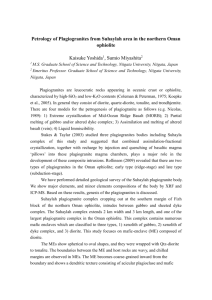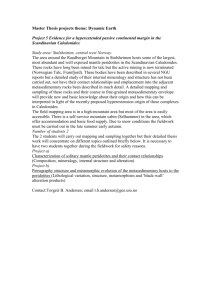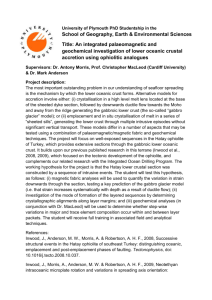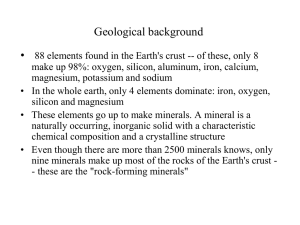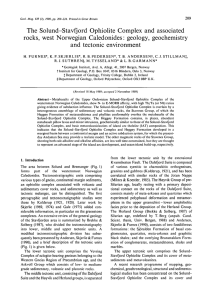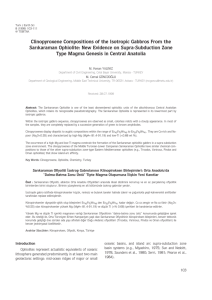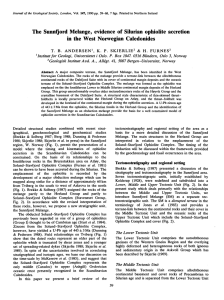Lithos, 27 (1992) 259-277
advertisement
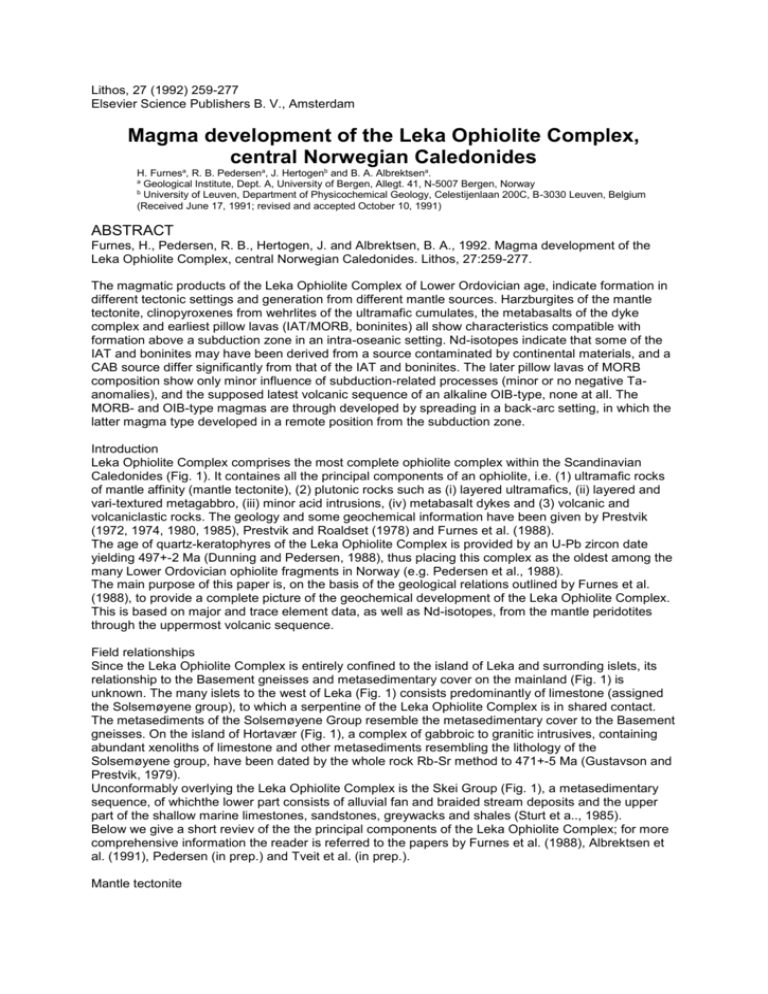
Lithos, 27 (1992) 259-277 Elsevier Science Publishers B. V., Amsterdam Magma development of the Leka Ophiolite Complex, central Norwegian Caledonides H. Furnesa, R. B. Pedersena, J. Hertogenb and B. A. Albrektsena. a Geological Institute, Dept. A, University of Bergen, Allegt. 41, N-5007 Bergen, Norway b University of Leuven, Department of Physicochemical Geology, Celestijenlaan 200C, B-3030 Leuven, Belgium (Received June 17, 1991; revised and accepted October 10, 1991) ABSTRACT Furnes, H., Pedersen, R. B., Hertogen, J. and Albrektsen, B. A., 1992. Magma development of the Leka Ophiolite Complex, central Norwegian Caledonides. Lithos, 27:259-277. The magmatic products of the Leka Ophiolite Complex of Lower Ordovician age, indicate formation in different tectonic settings and generation from different mantle sources. Harzburgites of the mantle tectonite, clinopyroxenes from wehrlites of the ultramafic cumulates, the metabasalts of the dyke complex and earliest pillow lavas (IAT/MORB, boninites) all show characteristics compatible with formation above a subduction zone in an intra-oseanic setting. Nd-isotopes indicate that some of the IAT and boninites may have been derived from a source contaminated by continental materials, and a CAB source differ significantly from that of the IAT and boninites. The later pillow lavas of MORB composition show only minor influence of subduction-related processes (minor or no negative Taanomalies), and the supposed latest volcanic sequence of an alkaline OIB-type, none at all. The MORB- and OIB-type magmas are through developed by spreading in a back-arc setting, in which the latter magma type developed in a remote position from the subduction zone. Introduction Leka Ophiolite Complex comprises the most complete ophiolite complex within the Scandinavian Caledonides (Fig. 1). It containes all the principal components of an ophiolite, i.e. (1) ultramafic rocks of mantle affinity (mantle tectonite), (2) plutonic rocks such as (i) layered ultramafics, (ii) layered and vari-textured metagabbro, (iii) minor acid intrusions, (iv) metabasalt dykes and (3) volcanic and volcaniclastic rocks. The geology and some geochemical information have been given by Prestvik (1972, 1974, 1980, 1985), Prestvik and Roaldset (1978) and Furnes et al. (1988). The age of quartz-keratophyres of the Leka Ophiolite Complex is provided by an U-Pb zircon date yielding 497+-2 Ma (Dunning and Pedersen, 1988), thus placing this complex as the oldest among the many Lower Ordovician ophiolite fragments in Norway (e.g. Pedersen et al., 1988). The main purpose of this paper is, on the basis of the geological relations outlined by Furnes et al. (1988), to provide a complete picture of the geochemical development of the Leka Ophiolite Complex. This is based on major and trace element data, as well as Nd-isotopes, from the mantle peridotites through the uppermost volcanic sequence. Field relationships Since the Leka Ophiolite Complex is entirely confined to the island of Leka and surronding islets, its relationship to the Basement gneisses and metasedimentary cover on the mainland (Fig. 1) is unknown. The many islets to the west of Leka (Fig. 1) consists predominantly of limestone (assigned the Solsemøyene group), to which a serpentine of the Leka Ophiolite Complex is in shared contact. The metasediments of the Solsemøyene Group resemble the metasedimentary cover to the Basement gneisses. On the island of Hortavær (Fig. 1), a complex of gabbroic to granitic intrusives, containing abundant xenoliths of limestone and other metasediments resembling the lithology of the Solsemøyene group, have been dated by the whole rock Rb-Sr method to 471+-5 Ma (Gustavson and Prestvik, 1979). Unconformably overlying the Leka Ophiolite Complex is the Skei Group (Fig. 1), a metasedimentary sequence, of whichthe lower part consists of alluvial fan and braided stream deposits and the upper part of the shallow marine limestones, sandstones, greywacks and shales (Sturt et a.., 1985). Below we give a short reviev of the the principal components of the Leka Ophiolite Complex; for more comprehensive information the reader is referred to the papers by Furnes et al. (1988), Albrektsen et al. (1991), Pedersen (in prep.) and Tveit et al. (in prep.). Mantle tectonite
